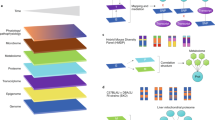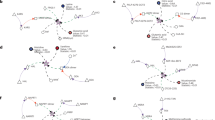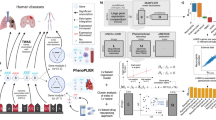Abstract
Metabolic control analysis (MCA) provides a quantitative description of substrate flux in response to changes in system parameters of complex enzyme systems. Medical applications of the approach include the following: understanding the threshold effect in the manifestation of metabolic diseases; investigating the gene dose effect of aneuploidy in inducing phenotypic transformation in cancer; correlating the contributions of individual genes and phenotypic characteristics in metabolic disease (e.g., diabetes); identifying candidate enzymes in pathways suitable as targets for cancer therapy; and elucidating the function of "silent" genes by identifying metabolic features shared with genes of known pathways. MCA complements current studies of genomics and proteomics, providing a link between biochemistry and functional genomics that relates the expression of genes and gene products to cellular biochemical and physiological events. Thus, it is an important tool for the study of genotype–phenotype correlations. It allows genes to be ranked according to their importance in controlling and regulating cellular metabolic networks. We can expect that MCA will have an increasing impact on the choice of targets for intervention in drug discovery.
This is a preview of subscription content, access via your institution
Access options
Subscribe to this journal
Receive 12 print issues and online access
$209.00 per year
only $17.42 per issue
Buy this article
- Purchase on Springer Link
- Instant access to full article PDF
Prices may be subject to local taxes which are calculated during checkout


Similar content being viewed by others
References
Weng, G., Bhalla, U.S. & Iyengar, R. Complexity in biological signaling systems. Science 284, 92–95 (1999).
Brent, R. Genomic biology. Cell 10, 169–183 (2000).
Lander, E.S. Array of hope. Nat. Genet. 21, 3–4 (1999).
Hieter, P. & Bogusky, M. Functional genomics: it's all how you read it. Science 278, 601–602 (1997).
Eisenberg, D., Marcotte, E.M., Xenarios, I. &Yates, T.O. Protein function in the post-genomic era. Nature 405, 823–826 (2000).
Schuster, S., Dandekar, T. & Fell, D.A. Detection of elementary flux modes in biochemical networks: a promising tool for pathway analysis and metabolic engineering. Trends Biotechnol. 17, 53–60 (1999).
Dang, C.V. & Semenza, G.L. Oncogenic alterations of metabolism. Trends Biochem. Sci. 24, 68–72 (1999).
Westerhoff, H.V., Koster, J.G., Van Workum, M. & Rudd, K.E. On the control of gene expression. in Control of metabolic processes (ed. Cornish-Bowden, A.) 399–412 (Plenum, New York, 1990).
Cornish-Bowden, A & Cárdenas, M.L. From genome to cellular phenotype—a role for metabolic flux analysis? Nat. Biotechnol. 18, 267–268 (2000).
Bailey, J.E. Reflections on the scope and the future of metabolic engineering and its connections to functional genomics and drug discovery. Metab. Eng. 3, 111–114 (2001).
Stephanopoulos, G. & Vallin, J.J. Network rigidity and metabolic engineering in metabolite overproduction. Science 252, 1675–1681 (1991).
Cornish-Bowden, A. Kinetics of multi-enzyme systems. in Biotechnology, a comprehensive treatise Vol. 9, Edn. 2 (eds. Rehm, H.-J & Reed, G.) 121–136 (Springer-Verlag, Weinheim, Germany, 1995).
Bailey, J.E. Lessons from metabolic engineering for functional genomics and drug discovery. Nat. Biotechnol. 17, 616–618 (1999).
Stephanopoulos, G. & Sinskey, A.J. Metabolic engineering—methodologies and future prospects. Trends Biotechnol. 11, 392–396 (1993).
Nielsen, J. Metabolic engineering: tecniques for analysis of targets for genetic manipulations. Biotechnol. Bioeng. 58, 127–132 (1998).
Savageau, M. Biochemical system analysis. A study of function and design in molecular biology (Addison-Wesley, Reading, MA, 1976).
Voit E.O. Computational analysis of biochemical systems (Cambridge University Press, Cambridge, 2000).
Fell, D. Understanding the control of metabolism (Portland Press, London, 1997).
Cornish-Bowden, A. & Cárdenas, M.L. Technological and medical implications of metabolic control analysis (Kluwer, Dordrecht, The Netherlands, 2000).
Rossignol, R., Letellier, T., Malgrat, M., Rocher, C., Mazat, J.P. Tissue variation in the control of oxidative phosphorylation: implication for mitochondrial diseases. Biochem J. 347, 45–53 (2000).
Cornish-Bowden, A. & Eisenthal, R. Prospects for pharmacological manipulation of metabolism. in New beer in an old bottle (ed. Cornish-Bowden, A.) 215–224 (Universitat de Valencia, Spain, 1997).
Salter, M., Knowles, R.G. & Pogson, C.I. Metabolic control. Essays Biochem. 28, 1–12 (1994).
Raamsdonk, L.M et al. A functional genomics strategy that uses metabolome data to reveal the phenotype of silent mutations. Nat. Biotechnol. 19, 45–50 (2001).
Cornish-Bowden, A. & Cárdenas, M.L. Complex networks of interactions connect genes to phenotypes. Trends Biochem. Sci. 26, 463–465 (2001).
Oliver, S.G. From DNA sequence to biological function. Nature 379, 597–600 (1996).
Teusink, B., Baganz, F., Westerhoff, H.V. & Oliver, S.G. Metabolic control analysis as a tool in the elucidation of the function of novel genes. Methods Microbiol. 26, 297–336 (1998).
Hofmeyr, J.H., Cornish-Bowden, A. & Rohwer, J.M. Taking enzyme kinetics out of control; putting control into regulation. Eur. J. Biochem. 212, 833–837 (1993).
Hofmeyr, J.H. & Cornish-Bowden, A. Co-response analysis: a new experimental strategy for metabolic control analysis. J. Theor. Biol. 182, 371–380 (1996).
Kholodenko, B.N., Schuster, S., Rohwer, J.M., Cascante, M. & Westerhoff, H.V. Composite control of cell function: metabolic pathways behaving as single control units. FEBS Lett. 368, 1–4 (1995).
Rohwer, J.M., Schuster, S. & Westerhoff, H.V. How to recognize monofunctional units in a metabolic system. J. Theoret. Biol. 179, 213–228 (1996).
Cornish-Bowden, A. & Cárdenas, M.L. Functional genomics. Silent genes given voice. Nature 409, 571–572 (2001).
Johnson, R.A. & Wichern, D.W. Applied multivariate statistical analysis Edn. 4 (Practice Hall, Englewood Cliffs, NJ, 1998).
Mazat, J.P. et al. What do mitochondrial diseases teach us about normal mitochondrial functions...that we already knew: threshold expression of mitochondrial defects. Biochim. Biophys. Acta, 1504, 20–30 (2001).
Agius, L. The physiological role of glucokinase binding and translocation in hepatocytes. Adv. Enzyme Regulation 38, 303–331 (1998).
Velho, G. et al. Impaired hepatic glycogen synthesis in glucokinase-deficient (MODY-2) subjects. J. Clin. Invest. 98, 1755–1761 (1996).
Froguel, P. et al. Familial hyperglycemia due to mutations in glucokinase. Definition of a subtype of diabetes mellitus. New Eng. J. Med. 328, 697–702 (1993).
Agius, L., Peak, M., Newgard, C.B., Gómez-Foix, A.M. & Guinovart, J.J. Evidence for a role of glucose-induced translocation of glucokinase in the control of hepatic glycogen synthesis. J. Biol. Chem. 271, 30479–30486 (1996).
Kacser, H. & Burns, J.A. The molecular basis of dominance. Genetics 97, 639–666 (1981).
Hollán, S. et al. Hereditary triosephosphate isomerase (TPI) deficiency: two severely affected brothers, one with and one without neurological symptoms. Hum. Genet. 92, 486–490 (1993).
Orosz, F., Vértessy, B.G., Hollán, S., Horányi, M. & Ovádi, J. Triosephosphate isomerase deficiency: predictions and facts. J. Theor. Biol. 182, 437–447 (1996).
Schuster, R. & Holzhütter, H.-G. Use of mathematical models for predicting the metabolic effect of large-scale enzyme activity alterations. Application to enzyme deficiencies of red blood cells. Eur. J. Biochem. 229, 403–418 (1995).
Mitelman, F. Catalogue of chromosome aberrations in cancer (Wiley-Liss, New York, 1994).
Mitelman, F., Mertens, F. & Johansson, B. A breakpoint map of recurrent chromosomal rearrangements in human neoplasia. Nat. Genet. 15, 417–474 (1997).
Sandberg, A.A. The chromosome in human cancer and leukemia Edn. 2 (Elsevier Science Publishing, New York, 1990).
von Hansemann, D. Ueber asymmetrische zellteilung in epithelkrebsen und deren biologische bedeutung. Virchows Arch. Pathol. Anat. 119, 299–336 (1890).
Boveri, T. Zur Frage der entstehung maligner Tumouren (Fisher, Jena, 1914).
Bauer K.H. Das Krebsproblem, Edn. 1 (Springer, Berlin, Göttingen and Heidelberg, 1963).
Rasnick, D. & Duesberg, P.H. How aneuploidy affects metabolic control and causes cancer. Biochem. J. 340, 621–630 (1999).
Warburg, O. The metabolism of tumors (Constable, London, 1930).
Warburg, O. On the origin of cancer cells. Science 123, 309–314 (1956).
Krebs., E.T. Jr., Krebs, E.T. Sr. & Beard, H.H. The unitarian or trophoblastic thesis of cancer. Med. Record 163, 150–171 (1950).
Horecker, B.L. Pathways of carbohydrate metabolism and their physiological significance. J. Chem. Ed. 42, 244–253 (1965).
Raylman, R.R., Fisher, S.J., Brown, R.S., Ethier, S.P. & Wahl, R.L. Fluorine-18-fluorodeoxyglucose-guided breast cancer surgery with a positron-sensitive probe: validation in preclinical studies. J. Nuclear Med. 36, 1869–1874 (1995).
Torizuka, T. et al. Myocardial oxidative metabolism in hyperthyroid patients assessed by PET with carbon-11-acetate. J. Nuclear Med. 36, 1811–1817 (1995).
Strauss, L.G. & Conti, P.S. The applications of PET in clinical oncology. J. Nuclear Med. 32, 623–648 (1991).
Bares, R. et al. F-18 fluorodeoxyglucose PET in vivo evaluation of pancreatic glucose metabolism for detection of pancreatic cancer. Radiology 192, 79–86 (1994).
Cascante, M, Centelles, J.J., Veech, R.L., Lee W-N.P. & Boros, L.G. Role of thiamin (vitamin B-1) and transketolase in tumor cell proliferation. Nutr. Canc. 36, 150–154 (2000).
Boros, L.G. et al. Transforming growth factor β2 promotes glucose carbon incorporation into nucleic acid ribose through the nonoxidative pentose cycle in lung epithelial carcinoma cells. Cancer Res. 60, 1183–1185 (2000).
Boros, L.G. et al. Oxythiamine and dehydroepiandrosterone inhibit the nonoxidative synthesis of ribose and tumor cell proliferation. Cancer Res. 57, 4242–4248 (1997).
Comin-Anduix, B. et al. The effect of thiamine supplementation on tumour proliferation. A metabolic control analysis study. Eur. J. Biochem. 268, 4177–4188 (2001).
Rais, B., et al. Oxythiamine and dehydroepiandrosterone induce a G1 phase cycle arrest in Ehrlich's tumor cells through inhibition of the pentose cycle. FEBS Lett. 456, 113–118 (1999).
Boros, L.G. et al. Wheat germ extract decreases glucose uptake and RNA ribose formation but increases fatty acid synthesis in MIA pancreatic adenocarcinoma cells. Pancreas 23, 141–147 (2001).
Boros, L.G., Bassilian, S., Lim, S. & Lee, W.N. Genistein inhibits nonoxidativa ribose synthesis in MIA pancreatic adenocarcinoma cells: a new mechanism of controlling tumor growth. Pancreas 22, 1–7 (2001).
Bakker, B.M., Michels, P.A., Opperdoes, F.R. & Westerhoff, H.V. Glycolysis in bloodstream form Trypanosoma brucei can be understood in terms of the kinetics of the glycolytic enzymes. J. Biol. Chem. 272, 3207–3215 (1997).
Eisenthal, R. & Cornish-Bowden, A. Prospects for antiparasitic drugs. The case of Trypanosoma brucei, the causative agent of African sleeping sickness. J. Biol. Chem. 273, 5500–5505 (1998).
Bakker, B.M., Michels, P.A., Opperdoes, F.R. & Westerhoff, H.V. What controls glycolysis in bloodstream form Trypanosoma brucei? J. Biol. Chem. 274, 14551–14559 (1999).
Michels, P.A. Compartmentation of glycolysis in trypanosomes: a potential target for new trypanocidal drugs. Biol. Cell 64, 157–164 (1988).
Bakker, B.M., Westerhoff, H.V., Opperdoes, F.R. & Michels, P.A. Metabolic control analysis of glycolysis in Trypanosomes as an approach to improve selectivity and effectiveness of drugs. Mol. Biochem. Parasitol 106, 1–10 (2000).
Cornish-Bowden, A. & Eisenthal, R. Computer simulation as a tool for studying metabolism and drug design. In Technological and medical implications of metabolic control analysis (eds. Cornish-Bowden, A. & Cárdenas, M.L.) 165–172 (Kluwer, Dordrecht, The Netherlands, 2000).
Kacser, H. & Small, J.R. How many phenotypes from one genotype? The case of Prion diseases. J. Theor. Biol. 182, 209–218 (1996).
Acknowledgements
This work was supported by grants from the Spanish Government Science Technology Ministry (PPQ2000-0688-C05-04) and Health Ministry (FISS 00-1120), the European Commission Grant INCO-COPERNICUS (ERBIC15CT960307), and the NATO Science Program (SA, LST.CLG.976283). The Biomedical Mass Spectrometry Facility is supported by USPHS grants P01-CA42710 to the UCLA Clinical Nutrition Research Unit, Stable Isotope Core, and M01-RR00425 to the General Clinical Research Center.
Author information
Authors and Affiliations
Corresponding author
Rights and permissions
About this article
Cite this article
Cascante, M., Boros, L., Comin-Anduix, B. et al. Metabolic control analysis in drug discovery and disease. Nat Biotechnol 20, 243–249 (2002). https://doi.org/10.1038/nbt0302-243
Received:
Accepted:
Issue Date:
DOI: https://doi.org/10.1038/nbt0302-243
This article is cited by
-
Simulated Learners in Educational Technology: A Systematic Literature Review and a Turing-like Test
International Journal of Artificial Intelligence in Education (2023)
-
Systems biology in cardiovascular disease: a multiomics approach
Nature Reviews Cardiology (2021)
-
A combined experimental and modelling approach for the Weimberg pathway optimisation
Nature Communications (2020)
-
Drug recommendation with minimal side effects based on direct and temporal symptoms
Neural Computing and Applications (2020)
-
Humanized yeast genetic interaction mapping predicts synthetic lethal interactions of FBXW7 in breast cancer
BMC Medical Genomics (2019)



